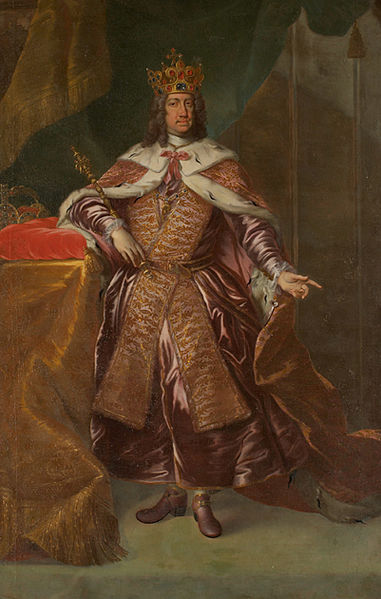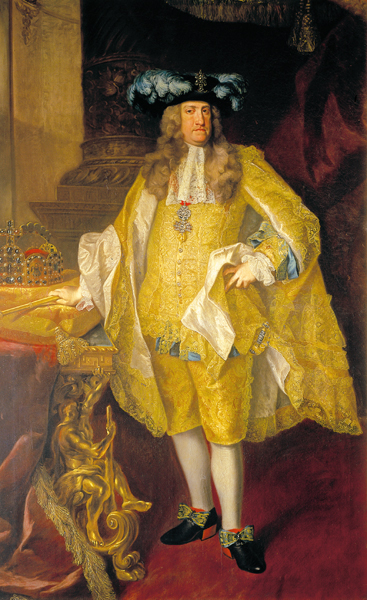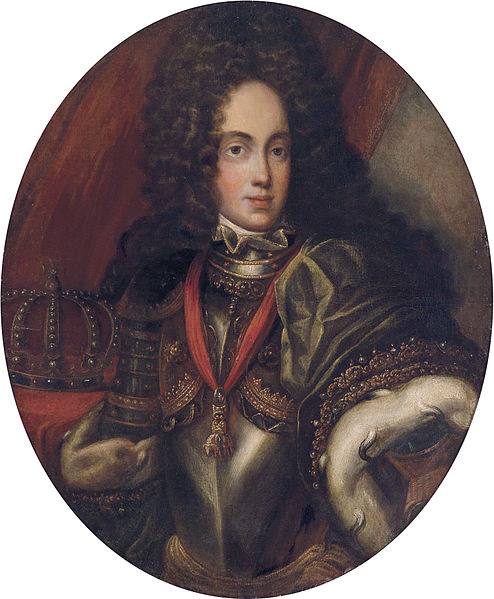<Back to Index>
- Aviation Pioneer William Edward Boeing, 1881
- Composer Paul Abraham Dukas, 1865
- Holy Roman Emperor Charles VI, 1685
PAGE SPONSOR



Charles VI (October 1685 – 20 October 1740) was the penultimate Habsburg sovereign of the Habsburg Empire. He succeeded his elder brother, Joseph I, as Holy Roman Emperor, King of Bohemia (Charles II), Hungary and Croatia (Charles III), Archduke of Austria, etc., in 1711. He unsuccessfully claimed the throne of Spain as Charles III following the death of its ruler, and Charles's relative, Charles II of Spain, in 1700. He married Elisabeth Christine of Brunswick - Wolfenbüttel, by whom he had his two children: Maria Theresa, born 1717, the last Habsburg sovereign, and Maria Anna, born 1718, Governess of the Austrian Netherlands.
Four years before the birth of Maria Theresa,
due to his lack of male heirs, Charles provided for a
male line succession failure with the Pragmatic Sanction of 1713. The
Emperor favoured his own daughters over those of his
elder brother and predecessor, Joseph I, in the
succession, ignoring the decree he had signed during
the reign of his father, Leopold I. Charles sought the other
European powers' approval. They exacted harsh terms:
England demanded that Austria abolish its overseas trading company. In total, Great Britain, France, Saxony - Poland, the Dutch Republic, Spain, Venice, States of the Church, Prussia, Russia, Denmark, Savoy - Sardinia, Bavaria, and the Diet of the Holy Roman
Empire recognised
the sanction. France, Spain, Saxony - Poland, Bavaria
and Prussia later reneged. Charles died in 1740,
sparking the War of the Austrian Succession, which
plagued his successor, Maria Theresa, for eight years.
Archduke Charles (baptised: Carolus Franciscus Josephus Wenceslaus Balthasar Johannes Antonius Ignatius), the second son of the Emperor Leopold I and of his third wife, Princess Eleonor Magdalene of the Palatinate, was born on 1 October 1685. His tutor was Anton Florian, Prince of Liechtenstein.
Following the death of Charles II of Spain, in 1700, without any ostensible heir, Charles declared himself King of Spain — both were members of the House of Habsburg. The ensuing War of the Spanish Succession, which pitted France's candidate, Philip, Duke of Anjou, Louis XIV of France's grandson, against Austria's, Charles, lasted for almost 14 years. The Kingdom of Portugal, Kingdom of England, Scotland, Ireland and the majority of the Holy Roman Empire endorsed Charles's candidature. Charles III, as he was known, disembarked in his kingdom in 1706, and stayed there for five years, only being able to exercise his rule in Catalonia, until the death of his brother, Joseph I, Holy Roman Emperor; he returned to Vienna to assume the emperorship. Not wanting to see Austria and Spain in personal union again, the new Kingdom of Great Britain withdrew its support from the Austrian coalition, and the war culminated with the Treaties of Utrecht and Rastatt three years later. The former, ratified in 1713, recognised Philip as King of Spain, however, the Kingdom of Naples, the Duchy of Milan, the Austrian Netherlands and the Kingdom of Sardinia -- all previously possessions of the Spanish — were delegated to Austria. To prevent a union of Spain and France, Philip was forced to renounce his right to succeed his grandfather's throne. Charles was extremely discontented at the loss of Spain, and as a result, he mimicked the staid Spanish Habsburg court ceremonial, adopting the dress of a Spanish monarch, which, according to British historian Edward Crankshaw, consisted of "a black doublet and hose, black shoes and scarlet stockings".
Charles's father and his advisors went about
arranging a marriage for him. Their eyes fell upon Elisabeth Christine of Brunswick -
Wolfenbüttel, the eldest child of Louis Rudolph, Duke of
Brunswick - Lüneburg. She was held to be
strikingly beautiful by her contemporaries. On 1 August
1708, in Barcelona, Charles married her by proxy. She gave him two
daughters that survived to adulthood, Maria Theresa
and Maria Anna.
Elisabeth Christine's inability to produce male heirs irked Charles and eventually led to the promulgation of the Pragmatic Sanction of 1713, a document which abolished male - only succession (hitherto effective in all the Habsburg realms) and declared his lands indivisible. The Emperor favoured his own daughters over those of his elder brother and predecessor, Joseph I, in the succession, ignoring the decree he had signed during the reign of his father, Leopold I. Charles sought the other European powers' approval. They exacted harsh terms: England demanded that Austria abolish its overseas trading company. In total, Great Britain, France, Saxony - Poland, the Dutch Republic, Spain, Venice, States of the Church, Prussia, Russia, Denmark, Savoy - Sardinia, Bavaria, and the Diet of the Holy Roman Empire recognised the sanction. France, Spain, Saxony - Poland, Bavaria and Prussia later reneged.
For a moment, however, it seemed that the Pragmatic Sanction was gratuitous, when Elisabeth Christine gave birth to a baby boy in 1716. Unfortunately, he died soon after. A year later, Maria Theresa, his elder surviving child, was born. At her baptismal ceremony, contemporaries wrote that Charles, despite his best efforts, appeared upset at the child's sex. The next year saw the arrival of another girl, Maria Anna.
Charles waged a productive conflict against the Ottoman Empire from 1716 to 1718. Austria came out of it with sizeable gains in Serbia and Royal Hungary, extending its empire to the Danube. Another war, that of Quadruple Alliance, soon followed. It too ended in an Austrian victory; by the Treaty of The Hague, Charles swapped Sardinia, which went to the Duke of Savoy, Victor Amadeus, for Sicily, the largest island in the Mediterranean, which was more difficult to defend from foreign aggression than Sardinia. The treaty also recognised Philip V of Spain's son, Don Carlos, as the heir to the Duchy of Parma and Grand Duchy of Tuscany; Charles had prior endorsed the succession of the incumbent Grand Duke's daughter, Anna Maria Luisa, Electress Palatine.
In 1722, Charles founded the Ostend Company to
augment Austria's trade with the East Indies, West Indies and
Africa. The charter was for a period of thirty years.
The Austrian exchequer was to receive between 3 to 6
percent of its annual surplus. The company was
unpopular with the British and the Dutch; and he was
forced to dissolve the company in 1731, by means of
the Treaty of Vienna, in exchange for
Britain's recognition of the Pragmatic Sanction.
Peace in Europe was shattered by the War of the Polish Succession (1733 – 1738), which started as a dispute over the throne of the Poland between Augustus of Saxony, the previous King's elder son, and Stanisław Leszczyński. Austria supported the former, France the latter; thus, a war broke out. The Treaty of Vienna concluded it in 1738; the Austrian candidate ascended the throne, however, Charles was obliged to surrender the Kingdom of Naples to Don Carlos of Spain, in exchange for the minuscule Duchy of Parma.
The issue of his elder daughter's marriage was raised early in her childhood. She was first engaged to be married to Léopold Clément of Lorraine, who was supposed to come to Vienna and meet Maria Theresa in 1723. Instead, news reached Vienna that he had died of smallpox, which upset Maria Theresa. Léopold Clément's younger brother, Francis Stephen, was invited to Vienna, but Maria Theresa's father considered other possibilities (such as marrying her to the future Charles III of Spain) before announcing the engagement of the couple. France demanded that Maria Theresa's fiancé surrender his ancestral Duchy of Lorraine to accommodate Stanisław Leszczyński, the deposed King of Poland. Maria Theresa's father compelled Francis to renounce his rights to Lorraine and told him: "No renunciation, no archduchess". They married in February 1736, and Lorraine devolved to France in July 1737.
In 1737, the Emperor embarked on another Turkish War with
Russia. Unlike the previous confrontation, it ended in
a decisive Austrian defeat. The territorial advances
made in the last Turkish War, under Prince Eugene of Savoy, in Bosnia, Serbia and Oltenia (Lesser Wallachia), were obliterated. Popular
discontent at the costly war reigned in Vienna. As a
result, Francis of Lorraine, Maria Theresa's consort,
was daubed a French spy by the Viennese.
At the time of his death, the Habsburg lands were saturated in debt; the exchequer contained a mere 100,000 florins; and desertion was rife in Austria's sporadic army, spread across the Empire in small, ineffective barracks. Contemporaries expected that Austrian - Hungary would wrench itself from the Habsburg yoke upon his death.
The Emperor died on 20 October 1740 at the Favorita Palace, Vienna. There is some evidence that Charles' death was caused by consuming a meal of death cap mushrooms. Charles' life opus, the Pragmatic Sanction, was ultimately in vain. Maria Theresa was forced to resort to arms to defend her inheritance from the coalition of Prussia, Bavaria, France, Spain, Saxony and Poland — all party to the sanction — who assaulted the Austrian frontier weeks after he died. The result: Maria Theresa lost the mineral rich Duchy of Silesia to Prussia, and the Duchy of Parma to Spain.
Emperor Charles VI has been the main motif of
many collectors' coins and medals. One of the most
recent samples is high value collectors' coin the
Austrian Göttweig Abbey commemorative coin,
minted in 11 October 2006. His portrait can be seen in
the foreground of the reverse of the coin.


